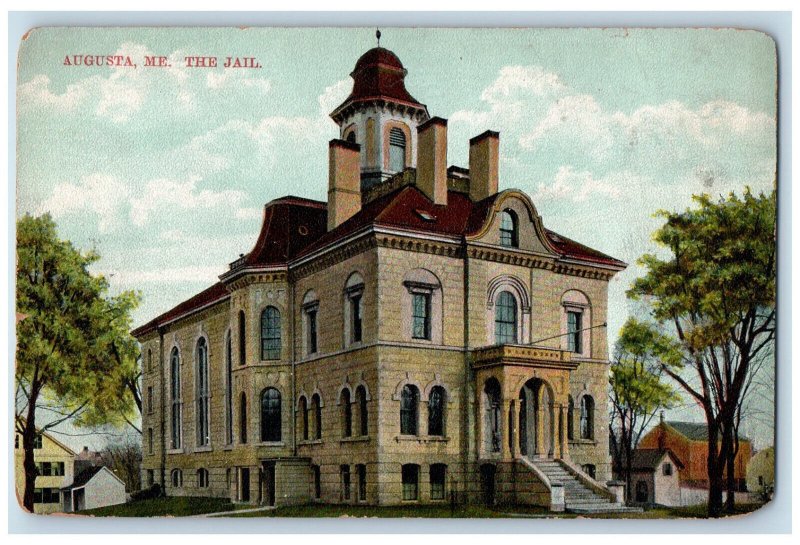Before proceeding to the history of the Augusta jail, your writer wants to clarify a sentence from last week’s article. It referenced Wikipedia’s statement that after Augusta became a city (instead of a town) in 1849, “Its early city offices were in the Opera House, and meetings took place in Winthrop Hall.”
Apparently “early” doesn’t mean from the beginning. The history of the Augusta Opera House, from James North’s 1870 history and other sources, was part of the Nov. 17, 2022, article in this series (about the Augusta fire department). It does not jibe with housing city offices in 1849.
The public buildings described in the 2022 article were at 296 Water Street. According to the article, citing North’s history, in the summer of 1865 (almost certainly a typographical error for 1866, after the great fire of Sept. 17, 1865), the Granite Block was built there.
This building had stores on the street level, offices on the second floor and on the third floor the public area named Granite Hall (not called an opera house). Granite Hall, North said, was 104-by-62-feet, 27 feet high, with galleries on three sides and a 62-by-24-foot stage.
Granite Hall was totally destroyed when Granite Block burned in the winter of 1890, the 2022 “Town Line” article continues. It then cites a July 4, 1896, Bangor newspaper article saying in 1891, the “first Opera House” was built on the same lot. It burned the night of July 3-4, 1896.
By then, the newspaper article said, the building’s second floor (between ground-floor stores and a third-floor opera house) housed “city government and city treasurer’s rooms and offices.” Also by then, according to Wikipedia (cited last week) the brick Augusta city hall at 1 Cony Street was under construction.
Observant readers will have noted that according to these sources, the first named Opera House was built in 1891; Granite Hall, which could have been used for operas, was built in 1865 or 1866. Neither existed in 1849.
When North wrote about choosing a mayor and getting the city council organized in February and March, 1850, the only meeting place he mentioned was Winthrop Hall.
* * * * * *

Kennebec County jail, in Augusta. Date unknown.
Fort Western and plans for the meeting house (built in 1782-83; see last week’s article in this series) were the only Hallowell public buildings North discussed in the 1760s and 1770s. The courthouse and the jail were then farther down the Kennebec, in the town that was incorporated in 1752 as Frankfort and became Pownalborough in 1760 and Dresden in 1784. (Dresden today is the town in which the historic Pownalborough Courthouse, built in 1760, stands.)
Capt. Charles Nash (author of the chapters on Augusta in Kingsbury’s 1892 Kennebec County history) and North, between them, presented a history of 18th-cenury public punishment in Hallowell/ Augusta. Nash explained that (Massachusetts) state law required towns to have public stocks and a whipping post, and fined those that failed to provide these “terrors to evil doers.”
Nash said public stocks were first ordered in 1775, without saying where they were (presumably in a public place; part of the point of forcing offenders to sit with their ankles through holes in a heavy wooden frame was to expose them to ridicule and torment). North mentioned that voters at the spring 1785 annual meeting voted “to build stocks.”
Both historians referenced a whipping post put up in 1786 (April, North said). Nash located it on Winthrop Street. North said a thief was whipped that month and three other men (two horse thieves and a counterfeiter) “as late as 1796” (Nash said the stocks and whipping post “fell into disuse” after the jail was built nearby in 1793).
In February, 1793, North said, a county committee accepted proposals for materials and labor to build a Hallowell jail. It went up the same year, a two-story building “with walls of hewn timber,” “small apertures…in the walls to admit light and air to the cells.”
Kingsbury located the jail at the intersection of State and Winthrop streets, “opposite the present court house.”
This first jail was “not very secure,” North wrote. He gave an example of a man who used his jackknife to enlarge a window, took off his clothes and squeezed through to freedom.
Nonetheless, the wooden jail lasted until March 16, 1808. That night, during the violence over land rights that convulsed the area now included in Windsor (the “Malta War” and the murder of surveyor Paul Chadwick), someone set what was by then the Augusta (no longer Hallowell) jail on fire. It burned to the ground.
There was an attempt to burn the courthouse, too, North wrote. A second-floor incendiary device there was discovered in time and extinguished.
Residents and officials at first assumed the arsonists were some of the squatters who had been resisting demands to either pay for or give up their land. Squatters may well have been responsible for the attempt at the courthouse, North said, but people decided the jail fire was most likely set by an inmate, Captain Edward Jones.
The jailer, Pitt Dillingham, had already moved records out of the building “in anticipation of such an event,” North wrote (without explaining whether Dillingham was wary of Jones, or of the general unrest). The prisoners were taken to a nearby house, under guard; none escaped, Kingsbury said.
The county sheriff promptly had a temporary jail built near the courthouse; the Court of Sessions approved it in April 1808. The court also ordered a new stone jail to be built immediately; appointed a building committee; and imposed an $8,000 county tax for the work.
But, North wrote, the legislature approved only $5,000. Construction went ahead anyway, partly because the county was spending a lot of money to guard prisoners in the insecure temporary jail.
The first prisoners were transferred to the new jail in December, before the work was completely finished, North said. In April 1809, another $3,000 county tax was levied.
This two-story jail was made from blocks of stone held together by iron dowels. It was “much in advance of the prison accommodations of that day,” North wrote, and was “considered a very expensive and secure structure.”
He described an alley-way separating rows of cells with “heavy iron doors” on each floor. The ground-floor cells, for “the worst criminals,” got light and air through six-by-24-inch openings in the stone walls. On the second floor, where debtors and people whose crimes were less serious were housed, each cell had a grated window.
The new jail was “connected, by a brick ell, to a two story square brick jail house” at the intersection of State and Winthrop streets, North said.
Kingsbury added a separate brick “keeper’s house,” still standing in 1892.
North, and an anonymous historian who put a history of the Hallowell jail and related issues on line, mentioned one incident in connection with the jail: Joseph Sager’s Jan. 2, 1835, hanging, after he was convicted of murdering his wife (with arsenic, in “some wine…in which was an egg with white sugar”) in October, 1834.
Sager claimed innocence, but failed to convince a jury, or the public. His mother’s last-minute effort to get the governor and council to intervene failed.
North wrote that the gallows was on Winthrop Street, “near the southwest corner of the jail” where Sager had been held. Despite a “cold and stormy” day, an estimated 8,000 to 12,000 people gathered.
Kennebec County Sheriff George W. Stanley was the official who executed Sager. His body hung for 20 minutes before he was pronounced dead. Afterwards, North reported, he was allegedly “buried with great secrecy on an island in a pond in Winthrop.”
North mentioned that the county attorney who prosecuted Sager was James W, Bradbury — the man your writer has cited frequently as author of the chapter on Kennebec County lawyers in Kingsbury’s history. He began his legal practice in Augusta in 1830, and Wikipedia says he was the county’s prosecuting attorney from 1834 to 1838.
The on-line historian says Sager’s was “the last execution carried out in the county.”
By the spring of 1857, North wrote, the county commissioners considered the 1808 jail unfit for use. He quoted from an unidentified source: it lacked “sufficient warmth, light, ventilation and cleanliness; it was inhuman, dangerous to life, and detrimental to health and good morals to imprison persons therein.”
The commissioners, North wrote, inspected the new Auburn jail and hired its designer, an important Boston architect named Gridley James Fox Bryant, to design one for them.
(The on-line historian says Bryant was educated at Maine’s Gardiner Lyceum and returned to the state to “design at least twenty buildings.” Listed as still standing in 2024 were the Knox and Penobscot County courthouses in Rockland and Bangor, respectively, and the Washington County jail in Machias. The Knox County courthouse and Washington County jail are on the National Register of Historic places.)
The commissioners then selected a nearby lot “where the courthouse used to stand” (on-line historian) and added abutting land to it; decided on a stone building (though the cost estimate for a brick one was $6,000 less); and on Sept. 16, 1857, opened nine bids to put up the building.
They awarded the contract to low bidder Charles Webb, from Bath, for $52, 287, North wrote. The total cost of land and building was around $60,000, funded by county bonds.
Webb’s crew started the foundation that fall; bad weather stopped work until the spring of 1858, when it was continued “with commendable dispatch.” Webb himself was on site; the on-line historian referenced an April “Kennebec Journal” account of Webb being knocked cold “by the recoil of a stone cart.”
Local and state authorities and the public were invited to tour the new jail on Feb. 1, 1859. North described it in detail, with dimensions (112-by-58-feet, 39.5 feet above the ground). An accompanying picture shows the three-story stone and brick building, topped with a cupola and weathervane.
The front and middle sections housed staff. North listed “eating, store and bathing rooms and store closet” in the front basement, with a “parlor, sitting-room and office” on the second floor and eight bedrooms in the third story and attic.
The kitchen was in the basement of the middle section. Above it was a 33-foot high “guard and inspection room.”
In the back section were 54 cells and eight larger “privilege rooms, or cells” (North did not explain them). Cells were mostly eight feet square, privilege rooms 19-by-8-feet. Doors, windows, and in each cell a bedstead and table were all made of iron.
Neither North nor the on-line historian said when the first prisoners arrived.
North, writing his history in 1870, had nothing more to say about the jail. The on-line historian concluded his 2024 account: “During the next 160 years, it was expanded in proportion and purpose to become today’s Kennebec County Corrections [Correctional] Facility,” at 115 State Street.
Main sources
Kingsbury, Henry D., ed. Illustrated History of Kennebec County Maine 1625-1892 (1892).
North, James W., The History of Augusta (1870).
Websites, miscellaneous.
 by Mary Grow
by Mary Grow













